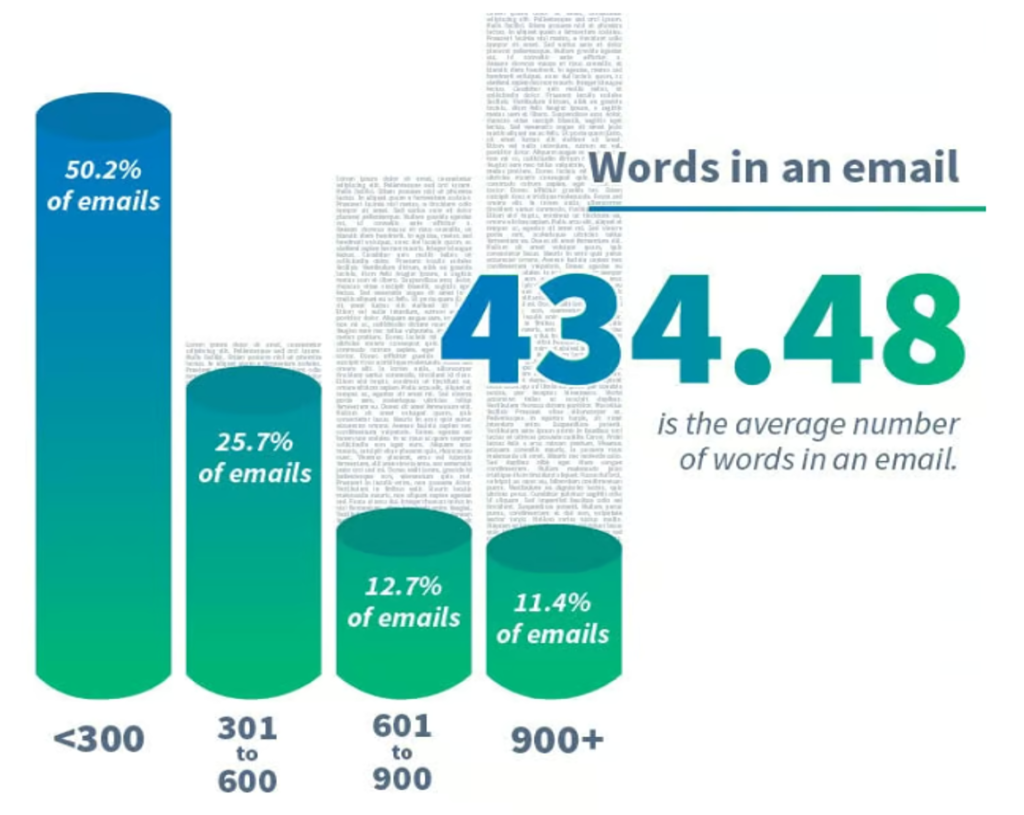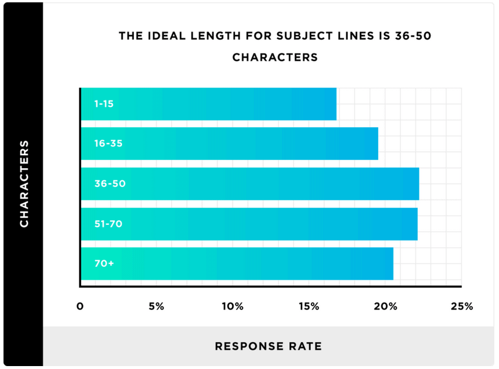- Home
- Email Tips and Tricks
- What Is the Ideal Email Length ...

Writing an email that leads to actual results means bringing together several things, such as engaging content, attractive design, as well as the proper sending time. The length of an email also plays a crucial role in a successful email campaign. Why? Because the right length can improve engagement, open rates, and conversions of a campaign, while the wrong one can do just the opposite.
While there is no ideal email length that fits all purposes, audiences, and industries, it is still possible to find a “sweet spot” for email length in each particular case. In this article, we will look at what is considered an optimal email length overall and look into cases when changing the optimal length might be the right solution.
How Long Should an Email Be?
When deciding how long an email can be, the answer really depends on your goals and audience. Nonetheless, some general guidelines still exist. Research suggests that while there’s no strict rules and one-size-fits-all decisions, keeping things short and to the point tends to get the best results.
It is considered that the ideal email length for marketing emails is around 434 words, which takes about 3.3 minutes to read. But here’s the thing—most people spend just 51 seconds reading an email after opening it. So, even though the average email length might be around 300 to 400 words, the reality shows that shorter emails often perform better for grabbing attention.

So, how long is too long for an email? Data suggests that emails with 50 to 125 words have a response rate above 50%. Another study found that emails with about 200 words (or roughly 20 lines of text) had the highest clickthrough rates. This means that for most emails, you should aim to keep things under 200 words for the best engagement. So, if you’re wondering how long a marketing email should be, the sweet spot is usually between 50 and 200 words.
Now, let’s talk about subject lines. Since many people check emails on their phones, the ideal subject line length falls between 28 and 50 characters (between 5 and 10 words), with 35 characters being a safe bet for mobile. And don’t forget about the pre-header, which should be between 40 and 100 characters. This little preview text gives readers more reason to open your email, so make sure it doesn’t get cut off on mobile.

Finally, when it comes to your CTA, keep it really short and on point. A good CTA should be 2 to 5 words. That’s why CTAs like ”Shop Now” or “Sign Up Today” work usually so well. A clear message conveyed in just a few words shows your readers exactly what to do without overthinking it.
How does email length affect open rates, click-through rates (CTR), and conversions?
When it comes to email open rates, the length of the email itself doesn’t directly affect them. What truly matters if you want to improve your open rates is the way you craft the subject line and preview text. For example, a subject line like “Limited Time Offer: 50% Off” is very on point, good for mobiles, and appeals to readers with limited time. Besides, short and punchy subject lines often reflect similarly concise email content, which is another plus.
More detailed subject lines, on the other hand, often promise longer in-depth content. Subject lines such as “Comprehensive Guide to Boosting Your Website Traffic” can attract readers looking for detailed information or expert insights.
Some findings insist that the shorter your subject line, the better, and suggest that marketers aim for 3–4 words for better open rates. While generally true, the key for both long and short emails is ensuring that the subject line and preview text clearly convey the email’s value and relevance to the reader. And if you are convinced that a subject line of 8 or 10 words conveys your email values best, go for it.
The length of an email is a significant factor that affects how actively users will click through it. Shorter emails tend to have higher CTRs since they can quickly present the main message and CTA to the reader.
Nonetheless, in some cases, short emails can lack enough context or detail, which might be essential for readers who need more information before taking action. This can happen in the case of newsletters or when a more complex product or offer is being promoted; a longer email that provides a detailed explanation and benefits might be more efficient.
Again, while each case shall be approached individually, findings suggest that for better CTR you should not go below 50 words and definitely not higher than 200. But keeping it in the 125–150 words, you might actually hit that sweet spot.
When it comes to conversions, an email length shall be defined by the type of nature of your offer. What does it mean? The advantage of shorter emails is in their ability to cause impulse-driven conversions. This works well when the offer is simple and easy to understand—such as a discount code or a limited-time sale. They work particularly well when the brand is well known and its products do not require additional introduction.
The situation will be, nonetheless, different for more complex or high-investment conversions, such as purchasing expensive products or signing up for a service with a long-term commitment.
In this case, users might be grateful for emails with longer explanations, additional details, or even reviews and FAQs. Like this, longer email will be rather perceived with gratitude, as it helps to alleviate doubts and build enough trust for the reader to commit to the conversion.
How email length varies for different types of marketing emails
Email newsletters
Email newsletters usually tend to be longer, as they contain a lot of content. They often include multiple sections like news, updates, promotions, or articles and can be up to around 500 words or sometimes more. The key to making a newsletter effective is breaking the content into sections. For this purpose, you can use headlines, images, and clear CTAs. Like this, you can present even big pieces of information to your users while keeping them engaged more than overwhelmed.
Welcome emails
Welcome emails can vary in length depending on how much you want to introduce yourself and your company. A brief welcome email (around 150–300 words) might simply thank the subscriber and provide a CTA to explore the website. A longer one (up to 500 words) might as well introduce your brand’s story, values, key products, or services. If your goal is relationship-building, longer welcome emails are more suitable, especially if they include incentives like a discount or a guide.
Re-engagement emails
Re-engagement emails can be either short or long—it depends on the message you want to convey. A shorter email of just a few lines might focus on a simple reason for the recipient to return, for example, a limited-time offer. Nonetheless, longer re-engagement emails may be good if you want to additionally explain the benefits of your product in more detail.
Transactional emails
Transactional emails, such as order confirmations, shipping notifications, or password resets, are usually very short. Since their main goal is to deliver important but brief information as quickly and clearly as possible, they usually do not exceed 100 words.
Event invitations
Email invitations need to convey the key event details—what, when, where, and why—followed by a strong CTA. It usually can be accomplished within 100–200 words. While the email itself should not be too long, it can include a link to a landing page for more detailed information about the event. Adding visuals or countdown timers can increase user engagement without requiring too much text.
Does Email Length Depend on the Industry?
If you’re wondering whether email length depends on the industry, the answer is both “yes” and “no.” While industry benchmarks can offer a useful starting point, they are not the only factor to consider when determining the ideal email length. Other elements, such as the goal of the email, the target audience, and the type of email being sent, are often more critical in deciding how long a professional email should be.
For example, in e-commerce, promotional emails are typically kept short, between 50 and 150 words, because they need to grab attention quickly. However, there are situations where a longer promotional email makes sense. It can be, for example, launching a premium or complex product. In this case, a more detailed email can be beneficial, as customers might require more context to fully understand the value proposition. In cases like this, product descriptions, testimonials, or even a story about the brand are perfect for building trust and guiding the reader toward a decision, in spite of a longer email.
Examples of email campaigns with short and long texts from different industries
On the contrary, industries like B2B or media often use longer emails, such as newsletters, where they share industry insights or thought leadership. However, there are times when it’s smart to shorten newsletters. For example, during busy periods like the holiday season or right after a product launch, a shorter newsletter with just the key highlights might be more effective.
So, while the industry can influence how long an email should be, it is never the sole determining factor. The goals of the email, the nature of the product or service, and the audience’s preferences are all becoming contributing factors in the quest for how long a marketing email should be.
How to Find the Perfect Email Length for Your Audience
A/B testing
A/B testing might be one of the best ways to determine the ideal email length for your audience. You can experiment with different versions of your email—shorter and longer ones. Like this, you’ll be able to compare important engagement metrics such as open rates, click-through rates, and conversion rates. With time, you’ll get enough information about how many words an email should be to provide you with maximum effectiveness in your case.
Use heatmaps and analytics
Heatmaps and analytics tools can show you how far down your readers scroll and where they tend to engage or drop off when going through your email. If readers consistently stop interacting after a certain point, it might be a sign that your email is too long or not engaging enough. By analyzing these behaviors, you can then better estimate where your email cutoff point should be.
Survey your audience
Sometimes, the best way to find out what works is to ask directly. Sending out a brief survey to your subscribers can provide you with the answers you are looking for. Ask questions like, “Do you prefer shorter or longer emails?” or “How much time are you ready to spend on reading an email?” With this feedback, you’ll better understand their preferences and will be able to adjust your strategy accordingly.
To Sum Up
In this article, we defined what the optimal email length is based on various research. We also found out that in spite of the golden email length standard, there are multiple cases in which making an email longer or shorter is the right decision. And this decision is never about just the type of email, industry, or product—but always is a combination of all those things.
So, sadly, there is no one-size-fits-all email length, and the recommended “between 50 and 200 words” shall be used rather as a recommendation, not the rule. So, take it as a starting point and build a campaign that will be primarily guided by your product, your audience, and your vision. If you do so, you’ll naturally find the best answer to the question of how long an email should be by making sure that your emails resonate with your subscribers on a profound level.
